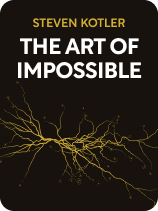

This article is an excerpt from the Shortform book guide to "The Art of Impossible" by Steven Kotler. Shortform has the world's best summaries and analyses of books you should be reading.
Like this article? Sign up for a free trial here .
What are the best strategies to achieve seemingly impossible goals? How do elite performers achieve goals we thought were unattainable?
Bestselling author Steven Kotler wrote The Art of Impossible after studying how elite performers achieve extremely difficult goals. Through his research, Kotler identified the habits of elite performers and turned them into strategies for achieving goals that seem impossible.
Read on to learn Kotler’s three actionable strategies for achieving goals you thought were impossible.
Steven Kotler’s The Art of Impossible
Goals feel impossible when you see no discernible way to get from where you are to where you want to be. However, this isn’t an excuse to give up on your dreams. Just because you’re currently unable to see a way doesn’t mean that there isn’t one.
In The Art of Impossible, bestselling author, award-winning journalist, and peak performance expert Steven Kotler draws on extensive neurobiological research to demystify what it takes to achieve breakthrough success. He presents strategies for developing peak performance habits that will help you to achieve your most ambitious goals.
3 Strategies to Achieve “Impossible” Goals
Once you’ve defined a seemingly impossible goal, you’ll have created enough intrinsic motivation to work towards defining a strategy to achieve your goal. Defining your strategy will give you a clear idea of what you need to do to get from where you are to where you want to be.
Kotler presents three steps to help you define your strategy to achieve your goal.
1. Break Your Seemingly Impossible Goal Down Into Challenging Tasks
The first step to create your strategy involves breaking your seemingly impossible goal down into achievable tasks. Kotler argues that this process helps you prioritize your time and focuses your attention on what you need to do to make progress.
- Break your life mission down into large, ambitious goals. Then, break these large goals into a series of challenging but achievable daily tasks. For example, your first daily task toward achieving your goal to set up a distribution network for agricultural solar technologies might be to define what resources you’ll need to move forward. Your second task might involve creating a plan to acquire these resources, and so on.
(Shortform note: Brendon Burchard (High Performance Habits) expands on Kotler’s method with in-depth advice on breaking your goal down into productive tasks. First, write down five major steps you need to take to achieve your goal. These are big steps that require many smaller tasks to achieve. For example, if your goal is to become a published author, one of your five major steps might be to get a literary agent. Then, under each of your five major steps, write down a list of tasks you need to complete to accomplish that step. For example, to get a literary agent, your tasks might include researching agencies and crafting writing samples. Finally, create deadlines for each of these tasks and factor them into your daily schedule.)
2. Set Your Schedule
The second step toward creating your strategy involves scheduling time for the tasks required to achieve your seemingly impossible goal. Kotler argues that setting aside blocks of time to accomplish your tasks and improve your skills produces the neurochemicals necessary to practice full engagement and amplify your focus and productivity.
This is because each time you complete a task, you’ll trigger a dopamine spike that will increase your motivation and concentration. In turn, this will make you want to improve your performance and tackle increasingly challenging tasks. By using this strategy, you’ll rapidly gain momentum toward achieving your seemingly impossible goal.
- Set aside at least 90 minutes of uninterrupted time each morning to accomplish your daily tasks.
(Shortform note: Psychological research offers additional insights into how scheduling uninterrupted time increases motivation and productivity. When you only give tasks partial focus—by multitasking or giving in to distractions—you interrupt your brain from accessing and applying information stored in your mind. This slows down your progress and makes your task feel laborious—thus, slowing down your momentum. On the other hand, intense, full focus helps your brain effortlessly sift through and apply information stored in your brain, speeds up your progress, and makes your task feel enjoyable—thus, increasing your momentum.)
- Commit to this schedule even when you’re feeling stressed out or exhausted. This strategy will train you to maintain focus for achieving goals during uncomfortable or difficult circumstances.
(Shortform note: Like Kotler, Brian P. Moran (The 12 Week Year) argues that you’re more likely to achieve your goals if you use strategies to work through your discomfort. Giving into excuses not to work on your goals leads to unproductive habits that slow down your momentum. On the other hand, committing to work on your goals no matter what helps you develop the necessary self-discipline and persistence required to maintain your focus over the long term.)
3. Expand Your Knowledge and Capabilities
The third step toward creating your strategy involves expanding your knowledge and skill set so that you can continually exceed your capabilities and move closer to achieving your goal. As we’ve discussed, Kotler claims that regularly learning new things encourages your brain to form connections between different ideas. This improves your problem-solving skills and your ability to come up with creative ideas. Further, the process of learning boosts levels of dopamine and norepinephrine in your system, making it easier to practice the strategy of full engagement and build momentum toward achieving your goal.
- In addition to your scheduled 90 minutes of uninterrupted time for task completion, spend 25 minutes a day learning something new or improving your skills. This could include reading about new topics, improving your areas of weakness, or practicing new skills.
| Strategies to Achieve Goals by Learning New Things If you’re not sure how to use your 25 minutes to effectively expand your knowledge and skills, consider adopting the following two strategies. According to Jim Kwik (Limitless), you’re more likely to retain the information you learn and expand your knowledge if you take effective notes. He provides a three-step process to achieve this: 1) Before you start a learning session (for example, reading or watching a presentation), ask yourself what you’re specifically hoping to learn from it. 2) Keeping your goal for the session in mind, filter through the information you’re getting, and write down only what’s relevant to that goal. 3) Once your session is complete, highlight the most valuable information and make an outline of the key points. Angela Duckworth (Grit) argues that you’re more likely to stretch your skill set if you break each skill down into different components and focus on mastering one component at a time. She provides a four-step process to achieve this: 1) Focus on a specific component of the skill you want to improve or learn. For example, if your goal is to learn how to play guitar, focus on mastering a single chord. Give that specific component your undivided attention. 2) Once you think you’ve mastered that component, ask others to evaluate your progress. Pay more attention to what you did wrong than what you did right. 3) Reflect on the feedback you received and continue to give that single component your undivided attention until you master it. 4) Repeat the process until you’ve mastered all of the different components of your chosen skill. |

———End of Preview———
Like what you just read? Read the rest of the world's best book summary and analysis of Steven Kotler's "The Art of Impossible" at Shortform .
Here's what you'll find in our full The Art of Impossible summary :
- A look at how some people can achieve seemingly impossible feats
- How to make your dreams more attainable
- A step-by-step process for developing peak performance habits






